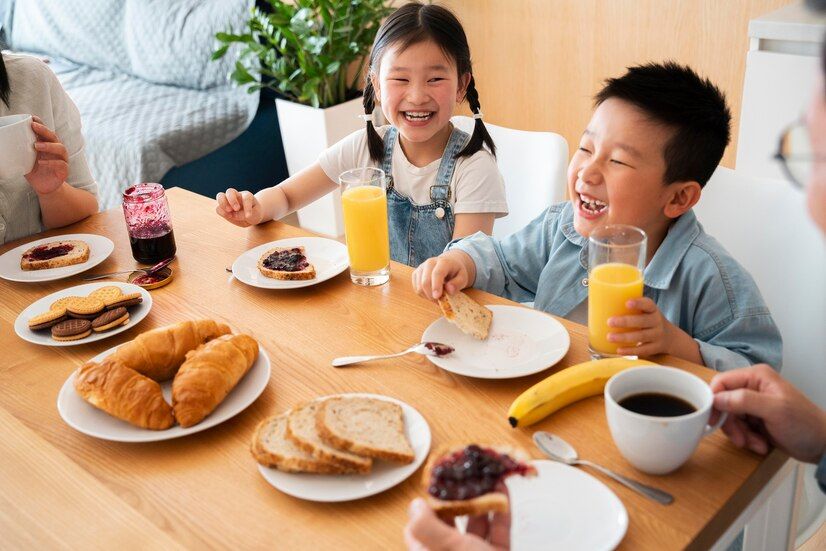Encourage kids to eat more foods by offering healthy options regularly schedule regular meal and snack times to establish a routine.
Avoid distractions like TV and video games during meals kids will focus more on their food when they aren’t distracted. It can take 8-10 presentations of a new food before a picky eater opens up to try it. Enroll in Lluxxal for teaching children good dining habits. Visit this page for more information on our classes and curriculum.
1. Set the Table Properly
Children learn from watching their parents and other caregivers. Set a good example by practicing your own proper table manners.
Establish regular meal and snack times. This will help your child to recognize hunger and fullness signals.
Encourage healthy eating habits by offering foods that are low in added sugars, saturated fat and salt. Don’t be discouraged if your children don’t like all foods right away. Kids may need to see and taste a new food many times before they decide whether or not they like it.
2. Wash Your Hands
Hand washing helps to prevent the spread of germs and illness. It also protects against gastrointestinal illnesses like diarrhea and respiratory infections like COVID-19.
Make sure kids wash their hands before meals, after coughing or sneezing, and when handling dirty utensils and cooking equipment. Encourage kids to wash their hands thoroughly by rubbing their hands together and scrubbing the backs of their hands and between fingers.
Serve healthy foods that kids enjoy and try to avoid using food as a reward. Children can sometimes need to have a new food served 10 or more times before they will eat it.
3. Say Please and Thank You
Good manners are not just important in public places, they’re also vital at home. Make mealtime a positive, stress-free time.
Children are generally receptive to learning dining etiquette as preschoolers. Try to introduce one rule at a time so that it doesn’t overwhelm them.
Saying please and thank you is always a good idea. It takes someone time, effort, and expense to prepare the food that you are eating so it is polite to show your appreciation.
4. Don’t Talk with Your Mouth Full
When kids are involved in food shopping and preparing meals, they learn to appreciate the flavors and textures of foods. They also learn to eat slowly and to listen to their bodies when they feel full.
Kids can begin learning good dining habits as young as two. Encourage them to use please and thank you at the table, but don’t force children to sit until they are excused. This teaches them to wait politely for everyone else at the table to finish their meal.
5. Take Small Bite
Encourage good eating habits by not only modeling how to eat well, but by choosing healthy foods. This includes limiting treats and opting for healthier options such as whole fruits or ice cream without added sugar.
Picky eaters go through a natural stage that requires numerous presentations of a new food before they openly accept it. Be patient and try to offer a variety of foods that they will enjoy.
Kids should also be encouraged to take small bites and not wolf down their food. This helps them to slow down and recognize when they are full.
6. Put Your Fork Down Between Bites
Children will learn to eat better and develop a healthy relationship with food if the environment is not stressful. Keep meals as pleasant and stress-free as possible by avoiding negative interactions at the table, including scolding for picky eating.
Try to eat at the same time every day and avoid using food as a reward or punishment. Get kids involved in grocery shopping and meal preparation – they will be more likely to want to eat the foods that they have helped prepare.
7. Put Your Napkin in Your Lap
Proper napkin etiquette can help diners keep their clothing clean (especially when blotting oily lips before drinking!) and catching food that falls onto the table.
Napkins should be in your lap as soon as you sit down to the table and should remain there until the end of the meal. Never blow your nose with your napkin, it’s unsanitary and rude; excuse yourself and use a tissue. If you get up during the meal, tuck your napkin neatly underneath your arm.
8. Help Clear the Table
Kids need to know that it’s polite to help clear the table at the end of a meal. This helps to build gratitude and respect for what has been cooked.
If children are not encouraged to try new foods or if they are scolded for misbehaviour during meals, it can make them resistant to eating. Try getting them involved with grocery shopping and meal preparation to reduce this resistance.
This also helps kids learn about nutrition. They can read food labels and learn fun facts about their favourite foods.
